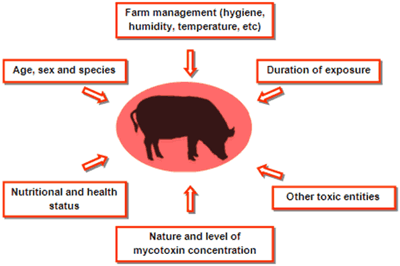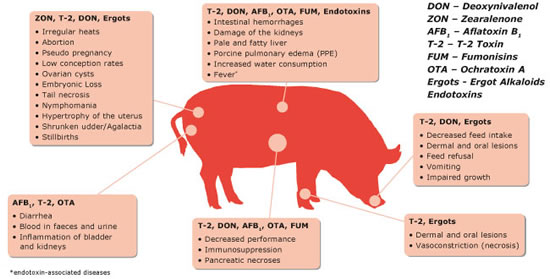
Pigs
Symptoms/Residues
The contamination of feedstuffs with mycotoxins poses a serious threat to the health and productivity of animals.Mycotoxicoses are animal or human diseases caused by mycotoxin ingestion, inhalation or skin-contact. The effects of mycotoxicoses in animals are diverse, varying from immune suppression to death in severe cases, depending on toxin-related (type of mycotoxin consumed, level and duration of intake), animal-related (species, sex, age, breed, general health, immune status, nutritional standing) and environmental (farm management, hygiene, temperature) factors.

Mycotoxins have different effects on the various organs and in the animal productivity and health. Below a simple explanation of the terms that will be used to describe the effects of mycotoxins in animals is given:
Immunosuppression: |
when one or more functions of the immune system are suppressed, resulting in an impaired resistance to infectious agents. |
Hematopoietic Effects: |
hematopoiesis refers to the production of all types of bloods cells from the primitive cells (stem cells) in the bone marrow. The dysfunction of hematopoiesis leads firstly to the decrease of production of neutrophils (white cells that help the cell to kill and digest microorganisms engulfed by phagocytosis), thus perturbing the animals’ immune system and subsequently to the decrease of red blood cells, leading to anemia. |
Hepatotoxic Effects: |
hepatotoxicity refers to liver damage caused by toxic substances. |
Nephrotoxic Effects: |
nephrotoxicity refers to kidney damage caused by toxic substances. Nephropathy is the term used to describe kidney inflammation. |
Reproductive Effects: |
involve all the negative impacts in the reproductive system and in reproduction. |
Teratogenic Effects: |
refer to birth defects, both structural and functional, caused to the newborn. |
Neurotoxic Effects: |
when the nervous system is affected. |
Carcinogenic Effects: |
involve the promotion of cancer and of the spread of cancer cells. |
Dermal Effects: |
Dermal toxicity involves all the damage caused to the skin by toxic substances. |
Gastro-intestinal Effects: |
involve all the effects which are caused in the gastro-intestinal tract. |
Performance Effects: |
involve the changes in performance that can be detected by lower daily weight gain, poor feed conversion rates, lower production (eggs, milk) and decreased feed intake. |
Pathological Effects: |
pathology refers to the study of organs in order to examine the effects of a certain disease. Changes from the normal appearance of a certain organ are known as pathological changes. |
Residues: |
refer to the mycotoxin carry-over into blood and muscles which may and often lead to residues in animal products such as meat and eggs. |
Effects of mycotoxins on the health of pigs

Information on the tables regarding the effects and symptoms of mycotoxins on animals was gathered from various sources. Field trials and scientific and laboratory research have been performed throughout the years leading to different discoveries and achievements in the mycotoxins field. Nevertheless, it should not be forgotten that mycotoxin contaminations are very complex in nature.
Some factors which complicate the process of dealing with mycotoxins are:
- Mycotoxins affect more than one system simultaneously, therefore producing a multiplicity of responses in the affected animals. This makes it harder to attribute the response to a single body system.
- The effects observed are not necessarily unique to a given mycotoxin but may be shared by other toxins and pathogenic organisms, making it harder to establish a cause-effect relationship for individual mycotoxins.
- Data gathered in experimental studies differ from the natural intoxications where there are many other factors (mentioned above) that can influence the disease condition. Also naturally caused mycotoxicoses are often more complex than those created in experimental studies due to the interactions between mycotoxins.
Due to these factors, it is possible that symptoms different to those presented below occur in animals. Younger animals are generally more susceptible to the toxic effects of all mycotoxins.
Mycotoxicoses in pigs

| Effects | Signs/Symptoms | ||
| Aflatoxins | Swine | Carcinogenic effects | Higher incidence of cancer in exposed animals |
| Immunosuppression | Decreased resistance to environmental and microbial stressors Increased susceptibility to diseases |
||
| Decreased performance | Reduced feed intake Feed refusal Impaired FCR |
||
| Hepatotoxic effects | Toxic hepatitis | ||
| Nephrotoxic effects | Kidney inflammation | ||
| Hematopoietic effects | Systemic hemorrhages | ||
| Residues | Residues and metabolites in liver and milk |
| Effects | Signs/Symptoms | ||
| Ochratoxin A | Swine | Decreased performance | Reduced weight gain Impaired FCR Increased mortality |
| Nephrotoxic effects | Kidney damage (porcine nephropathy) Increased water consumption Kidney and bladder dysfunction Altered urine excretion (wet beds) |
||
| Hepatotoxic effects | Liver damage | ||
| Gastro-intestinal effects | Diarrhea | ||
| Immunosuppression | Decreased resistance to environmental and microbial stressors Increased susceptibility to diseases |
||
| Residues | Residues present in the kidneys, liver and meat |
| Effects | Signs/Symptoms | ||
| Trichothecenes | Swine | Gastro-intestinal effects (DON) | Vomiting Diarrhea |
| Immunosuppression (T-2 toxin) |
Decreased resistance to environmental and microbial stressors Increased susceptibility to diseases Affects immune cells and modifies immune response |
||
| Decreased performance | Feed refusal Decreased weight gain Impaired FCR |
||
| Hematopoietic effects | Hemorrhages Hematological disorders |
||
| Teratogenic effects | Splaylegs | ||
| Dermal effects | Oral and dermal lesions Necrosis |
| Effects | Signs/Symptoms | ||
| Zearalenone | Female swine | Reproductive effects | Affected reproduction cycle, conception, ovulation and implantation Pseudo pregnancy, abortion, anoestrus, nymphomania Embryonic death, inhibition of fetal development, decreased number of fetuses (reduced litter size) Enlargement of mammary glands Swelling and reddening of vulva Rectal and vaginal prolapse |
| Pathological changes | Atrophy of ovaries Uterus hypertrophy |
||
| Male swine | Reproductive effects | Feminization Enlargement of mammary glands Impaired semen quality Testicular atrophy Swollen prepuce |
|
| Piglets | Reproductive effects | Reddened teats (females) Swelling and reddening of vulva (females) |
|
| Teratogenic effects | Splaylegs |
| Effects | Signs/Symptoms | ||
| Fumonisins | Swine | Immunosuppression | Decreased resistance to environmental and microbial stressors Increased susceptibility to diseases |
| Pulmonary and cardiovascular effects | Porcine pulmonary edema (PPE) | ||
| Pathological changes | Pancreatic necroses | ||
| Hematopoietic effects | Hematological disorders | ||
| Hepatotoxic effects | Liver damage | ||
| Residues | Residues in kidneys and liver |
| Effects | Signs/Symptoms | ||
| Ergot Alkaloids | Pigs | Neurotoxic effects | Low prolactin production Agalactia Low colostrum production |
| Decreased performance | Reduced weight gain | ||
| Reproductive effects | Shrunken udders Signs of estrus Stillbirths Reduced pregnancy rate Abortions |
||
| Pathological changes | Vasoconstriction Ear, tail and hoofs necrosis |






